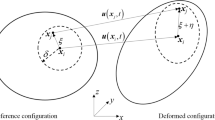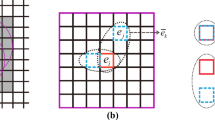Abstract
In this study, a posteriori error estimation and goal-oriented mesh adaptivity are developed for phase-field fracture propagation. Goal functionals are computed with the dual-weighted residual (DWR) method, which is realized by a recently introduced novel localization technique based on a partition-of-unity (PU). This technique is straightforward to apply since the weak residual is used. The influence of neighboring cells is gathered by the PU. Consequently, neither strong residuals nor jumps over element edges are required. Therefore, this approach facilitates the application of the DWR method to coupled (nonlinear) multiphysics problems such as fracture propagation. These developments then allow for a systematic investigation of the discretization error for certain quantities of interest. Specifically, our focus on the relationship between the phase-field regularization and the spatial discretization parameter in terms of goal functional evaluations is novel.















Similar content being viewed by others
References
Ainsworth M, Oden JT (1997) A posteriori error estimation in finite element analysis. Comput Methods Appl Mech Eng 142(1–2):1–88
Ambati M, Gerasimov T, De Lorenzis L (2015) A review on phase-field models of brittle fracture and a new fast hybrid formulation. Comput Mech 55(2):383–405
Ambrosio L, Tortorelli V (1990) Approximation of functionals depending on jumps by elliptic functionals via \(\gamma \)-convergence. Commun Pure Appl Math 43:999–1036
Ambrosio L, Tortorelli V (1992) On the approximation of free discontinuity problems. Boll Unione Mat Ital B 6:105–123
Amor H, Marigo J-J, Maurini C (2009) Regularized formulation of the variational brittle fracture with unilateral contact: numerical experiments. J Mech Phys Solids 57:1209–1229
Andersson J, Mikayelyan H (2015) The asymptotics of the curvature of the free discontinuity set near the cracktip for the minimizers of the Mumford–Shah functional in the plain. A revision. https://scirate.com/arxiv/1204.5328
Apel T, Saendig A-M, Whiteman JR (1996) Graded mesh refinement and error estimates for finite element solutions of elliptic boundary value problems in non-smooth domains. Math Methods Appl Sci 19(1):63–85
Artina M, Fornasier M, Micheletti S, Perotto S (2015) Anisotropic mesh adaptation for crack detection in brittle materials. SIAM J Sci Comput 37(4):B633–B659
Bangerth W, Rannacher R (2003) Adaptive finite element methods for differential equations. Lectures in mathematics. Birkhäuser, ETH, Zürich
Bangerth W, Hartmann R, Kanschat G (2007) deal.II—a general purpose object oriented finite element library. ACM Trans Math Softw 33(4):24/1–24/27
Bangerth W, Heister T, Kanschat G (2012) Differential equations analysis library
Becker R, Rannacher R (1995) Weighted a posteriori error control in FE methods. In: Bock eaHG (ed) ENUMATH’97. World Sci. Publ., Singapore
Becker R, Rannacher R (2001) An optimal control approach to error control and mesh adaptation in finite element methods. In: Iserles A (ed) Acta Numerica 2001. Cambridge University Press, Cambridge, pp 1–102
Belletini G, Coscia A (1994) Discrete approximation of a free discontinuity problem. Numer Funct Anal Optim 15:201–224
Blum H, Suttmeier F-T (1999) An adaptive finite element discretisation for a simplified Signorini problem. Calcolo 37(2):65–77
Blum H, Suttmeier F-T (2000) Weighted error estimates for finite element solutions of variational inequalities. Computing 65(2):119–134
Bonnet A, David G (2001) Cracktip is a global Mumford–Shah minimizer. Asterisque no. 274
Borden MJ, Verhoosel CV, Scott MA, Hughes TJR, Landis CM (2012) A phase-field description of dynamic brittle fracture. Comput Methods Appl Mech Eng 217:77–95
Borden MJ, Hughes TJ, Landis CM, Verhoosel CV (2014) A higher-order phase-field model for brittle fracture: formulation and analysis within the isogeometric analysis framework. Comput Methods Appl Mech Eng 273:100–118
Bourdin B (2007) Numerical implementation of the variational formulation for quasi-static brittle fracture. Interfaces Free Bound 9:411–430
Bourdin B, Francfort G, Marigo J-J (2000) Numerical experiments in revisited brittle fracture. J Mech Phys Solids 48(4):797–826
Bourdin B, Francfort G, Marigo J-J (2008) The variational approach to fracture. J Elast 91(1–3):1–148
Bourdin B, Chukwudozie C, Yoshioka K (2012) A variational approach to the numerical simulation of hydraulic fracturing. SPE Journal, conference paper 159154-MS
Braack M, Ern A (2003) A posteriori control of modeling errors and discretization errors. Multiscale Model Simul 1(2):221–238
Braides A (1998) Approximation of free-discontinuity problems. Springer, Berlin
Burke S, Ortner C, Süli E (2010) An adaptive finite element approximation of a variational model of brittle fracture. SIAM J Numer Anal 48(3):980–1012
Burke S, Ortner C, Süli E (2013) An adaptive finite element approximation of a generalized Ambrosio–Tortorelli functional. M3AS 23(9):1663–1697
dal Maso G, Francfort GA, Toader R (2005) Quasistatic crack growth in nonlinear elasticity. Arch Ration Mech Anal 176:165–225
Eriksson K, Estep D, Hansbo P, Johnson C (1995) Introduction to adaptive methods for differential equations. In: Iserles A (ed) Acta Numerica 1995. Cambridge University Press, Cambridge, pp 105–158
Francfort G, Marigo J-J (1998) Revisiting brittle fracture as an energy minimization problem. J Mech Phys Solids 46(8):1319–1342
Gerasimov T, Lorenzis LD (2015) A line search assisted monolithic approach for phase-field computing of brittle fracture. Comput Methods Appl Mech Eng. doi:10.1016/j.cma.2015.12.017
Giles M, Süli E (2002) Adjoint methods for PDEs: a posteriori error analysis and postprocessing by duality. In: Iserles A (ed) Acta Numerica 2002. Cambridge University Press, London, pp 145–236
Griffith AA (1921) The phenomena of rupture and flow in solids. Philos Trans R Soc Lond 221:163–198
Großmann C, Roos H-G (2005) Numerische Behandlung partieller Differentialgleichungen. Teubner-Studienbücher Mathematik; Lehrbuch Mathematik. Teubner, Wiesbaden, 3, völlig überarb. und erw. aufl. edition, 2005
Heister T, Wheeler MF, Wick T (2015) A primal–dual active set method and predictor–corrector mesh adaptivity for computing fracture propagation using a phase-field approach. Comput Methods Appl Mech Eng 290:466–495
Hintermüller M, Hoppe R, Löbhard C (2014) Dual-weighted goal-oriented adaptive finite elements for optimal control of elliptic variational inequalities. ESAIM Control Optim Calc Var 20:524–546
Hoitinga W, van Brummelen E (2011) Goal-oriented adaptive methods for a Boltzmann-type equation. In: AIP conference proceedings, vol 1333. American Institute of Physics, p 81–86
Kikuchi N, Oden J (1988) Contact problems in elasticity. Studies in applied mathematics. Society for Industrial and Applied Mathematics (SIAM), Philadelphia
Kuru G, Verhoosel C, van der Zee K, van Brummelen E (2014) Goal-adaptive isogeometric analysis with hierarchical splines. Comput Methods Appl Mech Eng 270:270–292
Kuzmin D, Korotov S (2010) Goal-oriented a posteriori error estimates for transport problems. Math Comput Simul 80(8):1674–1683
Lee S, Mikelic A, Wheeler M, Wick T (2016) Phase-field modeling of proppant-filled fractures in a poroelastic medium. ICES-report 16-03. Comput Methods Appl Mech Eng. doi:10.1016/j.cma.2016.02.008
Mesgarnejad A, Bourdin B, Khonsari M (2015) Validation simulations for the variational approach to fracture. Comput Methods Appl Mech Eng 290:420–437
Meyer C, Rademacher A, Wollner W (2015) Adaptive optimal control of the obstacle problem. SIAM J Sci Comput 37(2):A918–A945
Miehe C, Hofacker M, Welschinger F (2010a) A phase field model for rate-independent crack propagation: robust algorithmic implementation based on operator splits. Comput Methods Appl Mech Eng 199:2765–2778
Miehe C, Welschinger F, Hofacker M (2010b) Thermodynamically consistent phase-field models of fracture: variational principles and multi-field FE implementations. Int J Numer Methods Eng 83:1273–1311
Mikelić A, Wheeler MF, Wick T (2015a) A phase-field method for propagating fluid-filled fractures coupled to a surrounding porous medium. SIAM Multiscale Model Simul 13(1):367–398
Mikelić A, Wheeler MF, Wick T (2015b) Phase-field modeling of a fluid-driven fracture in a poroelastic medium. Comput Geosci 19(6):1171–1195
Mikelić A, Wheeler MF, Wick T (2015c) A quasi-static phase-field approach to pressurized fractures. Nonlinearity 28(5):1371–1399
Oden J, Prudhomme S (1999) On goal-oriented error estimation for elliptic problems: application to the control of pointwise errors. Comput Methods Appl Mech Eng 176:313–331
Peraire J, Patera A (1998) Bounds for linear-functional outputs of coercive partial differential equations: local indicators and adaptive refinement. In: Ladeveze P, Oden J (eds) Advances in adaptive computational methods in mechanics. Elsevier, Amsterdam, pp 199–215
Rannacher R, Suttmeier F-T (1997) A feed-back approach to error control in finite element methods: application to linear elasticity. Computational Mechanics 19(5):434–446
Rannacher R, Suttmeier F-T (1998) A posteriori error control in finite element methods via duality techniques: Application to perfect plasticity. Computational Mechanics 21(2):123–133
Rannacher R, Suttmeier F-T (1999) A posteriori error estimation and mesh adaptation for finite element models in elasto-plasticity. Computer Methods in Applied Mechanics and Engineering 176(1–4):333–361
Rannacher R, Suttmeier F-T (2000) Error estimation and adaptive mesh design for FE models in elasto-plasticity. In: Stein E (ed) Error-Controlled Adaptive FEMs in Solid Mechanics. Wiley, Chichester
Rice J (1968) Mathematical analysis in the mechanics of fracture, pages 191–311. Academic Press, New York, chapter 3 of fracture: an advanced treatise edition
Richter T (2012) Goal-oriented error estimation for fluid–structure interaction problems. Comput Methods Appl Mech Eng 223–224:38–42
Richter T, Wick T (2015) Variational localizations of the dual weighted residual estimator. J Comput Appl Math 279:192–208
Rueter M, Stein E (2006) Goal-oriented a posteriori error estimates in linear elastic fracture mechanics. Comput Methods Appl Mech Eng 195(46):251–278
Rüter M, Gerasimov T, Stein E (2013) Goal-oriented explicit residual-type error estimates in XFEM. Comput Mech 52(2):361–376
Schlüter A, Willenbücher A, Kuhn C, Müller R (2014) Phase field approximation of dynamic brittle fracture. Comput Mech 54:1141–1161
Schroeder A, Rademacher A (2011) Goal-oriented error control in adaptive mixed FEM for Signorini’s problem. Comput Methods Appl Mech Eng 200(1–4):345–355
Sneddon IN (1946) The distribution of stress in the neighbourhood of a crack in an elastic solid. Proc R Soc Lond A 187:229–260
Sneddon IN, Lowengrub M (1969) Crack problems in the classical theory of elasticity. SIAM series in applied mathematics. Wiley, Philadelphia
Suttmeier F (2008) Numerical solution of variational inequalities by adaptive finite elements. Vieweg+Teubne, Wiesbaden
Suttmeier F-T (2001) General approach for a posteriori error estimates for finite element solutions of variational inequalities. Comput Mech 27(4):317–323
Tran D, Settari AT, Nghiem L (2013) Predicting growth and decay of hydraulic-fracture witdh in porous media subjected to isothermal and nonisothermal flow. SPE J 18(4):781–794
Wheeler M, Wick T, Wollner W (2014) An augmented-Lagrangian method for the phase-field approach for pressurized fractures. Comput Methods Appl Mech Eng 271:69–85
Wick T (2015) Dual-weighted residual adaptivity for phase-field fracture propagation. PAMM 15(1):619–620
Wriggers P (2006) Computational contact mechanics. Springer, Berlin
Zee K, Brummelen E, Akkerman I, Borst R (2011) Goal-oriented error estimation and adaptivity for fluid–structure interaction using exact linearized adjoints. Comput Methods Appl Mech Eng 200:2738–2757
Acknowledgments
I wish to thank the reviewers for their critical comments that helped to improve the manuscript. Moreover, I am grateful to Ivo Babuska (ICES, UT Austin) for very initial discussions on error estimation of finite element discretizations for fracture modeling during my 2-year-stay at ICES from 2012 to 2014. The same acknowledgments go to Franz-Theo Suttmeier (Univ. Siegen) who gave some hints to mesh adaptation strategies for quasi-stationary evolution problems. Finally, I thank Mary F. Wheeler (ICES, UT Austin) and Andro Mikelić (Univ. Lyon) for our joint start on phase-field fracture modeling in poroelasticity and in particular pressurized fracture techniques.
Author information
Authors and Affiliations
Corresponding author
Rights and permissions
About this article
Cite this article
Wick, T. Goal functional evaluations for phase-field fracture using PU-based DWR mesh adaptivity. Comput Mech 57, 1017–1035 (2016). https://doi.org/10.1007/s00466-016-1275-1
Received:
Accepted:
Published:
Issue Date:
DOI: https://doi.org/10.1007/s00466-016-1275-1




